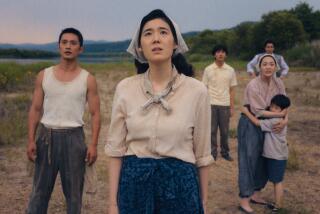Kimono Lisa : THE LADY AND THE MONK: Four Seasons in Kyoto, <i> By Pico Iyer (Alfred A. Knopf: $22; 352 pp.)</i>
The news from Japan is a relentless montage of economic stories--scandals at Nomura Securities, new engines from Honda, a takeover by Matsushita, government ministry concerns about karoshi , death from overwork. It is a relief to find that Pico Iyer’s new book, “The Lady and the Monk,” dwells on none of these things. At a time when Americans are obsessed with Japan’s economic might, Iyer’s book is about his own quest for a more ancient land of monks, rock gardens and paper lanterns. Even more challenging, it is his search for spiritual enlightenment in the land of the economic miracle.
In his previous book, “Video Night in Katmandu,” Iyer scoured Asia for ways that Western pop culture had grown around the ancient cultural roots of the Orient. In “The Lady and the Monk,” Iyer tries to look behind the clutter of modern times to see if an older Japan--from the floating world found in the woodblock prints of Hokusai to the snow country of the novelist Kawabata--still exists. Like a cultural archeologist, Iyer digs into the dead metaphors of poets and beneath the antiseptic glitz of love hotels to unearth traces of his own misty nostalgia for a bygone Japan.
While looking for the past, Iyer spends a lot of time rubbernecking at more contemporary collisions between East and West. He sees the most gruesome cross-cultural fender benders in T-shirts and ad copy, where Japanese are fond of playing unintentionally surrealistic games with the strange sounds of the English language: “shy teenage girls whose coats said ‘dental democracy’ . . . the machine that offered Drink Paradise and Your Joyful Drink . . . a coffee shop whose window announced, unexpectedly, ‘I’d like to eat with you and gaze into your eyes while we talk of UFOs.’ ”
“The Lady and the Monk” is part of a long tradition of books about Westerners searching for solitude and inner peace in an alien Oriental land. It is also a kind of aesthetic exorcism as Iyer tries to recall, in his own writing, Japanese masters of mood like Tanizaki Junichiro. In four sections, the book consciously passes like the seasons. Here is winter: “When I awoke, the flakes were coming down in long silent flurries, falling soundlessly on gray roofs and canals, falling down upon dark temples and back streets, leaving scant trace of the buildings, making no sound as it made the city new.”
The city is Kyoto, Japan’s ancient capital. Here is where Iyer, like so many Dharma bums before him, seeks to find the purity of ancient Japan. His first stop is a Zen temple. A friend warns him that the appeal of Zen to foreigners is like a mountain wrapped in mist: From afar, Westerners see the beautiful mist; up close, facing the icy discipline of a tough roshi (Zen master), they see nothing but hard rock. Iyer hits rock by Page 30 and moves across town to a small tatami room, shared by other part-time seekers of enlightenment.
Luckily for the reader, Iyer is too much of the world to leave it. In his writing, he is a kind of ascetic observer of the commerce and carnality around him. But he can no more join the fray than he can stop watching, and, in dreamlike, beautiful prose, write down what he sees.
In his literary quest for enlightenment, he finds two poets who crystallize Japan’s ambiguity toward the spirit and the flesh. The monkish side of Iyer is fond of the words of an old ascetic named Ryokan:
If your hermitage is deep in the mountains,
Surely the moon, flowers and maples
Will become your friends.
The more worldly side of the author is seduced by the carnality of a monk-teasing woman named Yosano Akiko in a collection called “Midaregami” (Tangled Hair):
You have yet to touch
This soft flesh
This throbbing blood--
Are you not lonely,
Explainer of the Way?
As the seasons pass, all these rich themes--East and West, spirit and flesh, old and new--become entangled in the author’s relationship with a woman named Sachiko. Sachiko is the Lady to Iyer’s Monk. She leads him away from the solitary path and takes him into more interesting emotional territory.
If at times--too often for my taste--Iyer uses Sachiko as an emblem of Japanese society itself, Sachiko does fit the profile of the typical Japanese woman. Mother of two, she is married to a sincere but limited man, more wed to his work than to Sachiko. While Sachiko dreams of a life outside her proscribed social role, her husband is content to be carried along on Japan’s conveyor-belt society. “My husband very kind but not so strong: usual Japanese situation. He want only usual life, very quiet life. He not have dream.”
Into her life, from Santa Barbara by way of England, comes the exotic Pico Iyer. At first, Sachiko sees his presence, like a good foreign film, as an escape from her quotidian prison. But gradually, she begins to fall in love with Iyer. And he--the purposefully monkish literary observer--seems strangely distant, drawn to her less by affection than by what she offers as an aesthetic object in a Japanese fantasy: “She greeted me at the door in soft-lined winter kimono, orange with the delicate outline of plum blossoms, a red ribbon wound around her tied-up hair, and snow white, spirit-toed socks around her feet. . . .”
The most moving part of this book is when Iyer allows himself to be drawn into the world of Sachiko and her female friends. Through him, we see vibrant, well-educated women struggling to confound the stereotypes of Japanese women as willing domestic servants. While their husbands are exhausted from overwork, or sleeping off hangovers from raucous company parties, Sachiko and her friends are seeing plays, listening to music, dabbling in local politics, writing stories and dreaming of a better life. In corporations and households, the role of Japanese women still is limited to pouring tea and caring for children. But in stolen moments and illicit affairs, the women in “The Lady and the Monk” are living fuller lives than are Japanese salary men.
“The Lady and the Monk” is a beautifully written book about someone looking for ancient dreams in a strange modern place. But, in the end, the author’s search for his own heart is not as convincing as his portrait of the quest of another.
Sachiko divorces her husband, goes abroad and defies the conformist social conventions of Japan. Iyer returns to his home in Santa Barbara, aware that Japan was “so much a part of my life that I had not even seen it until I was gone.” Japan becomes truest for him when it becomes a dream and memory. Sachiko finds a way to make her dreams real.
“The ultimate purpose of Zen, I remember the roshi telling me, ‘is not in the going away from the world but in the coming back. Zen is not just a matter of gaining enlightenment; it’s a matter of acting in a world of love and compassion.’ ” That is the sound of one hand clapping. For Sachiko.
More to Read
Sign up for our Book Club newsletter
Get the latest news, events and more from the Los Angeles Times Book Club, and help us get L.A. reading and talking.
You may occasionally receive promotional content from the Los Angeles Times.








